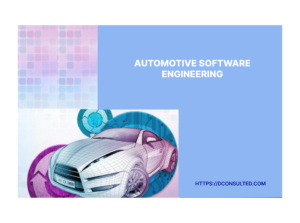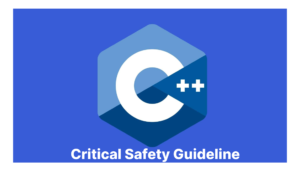
Enhancing Code Quality with Custom Rules in LLVM Static Analysis | DConsulted
Managing and optimizing thread overhead is important for safety-critical and embedded systems. Learn more about the C++ multithread common myths here.

In today’s rapidly evolving automotive landscape, creating safe and reliable systems is not only essential but expected. ASPICE (Automotive Software Process Improvement and Capability Determination) and ISO 26262 (Road Vehicles – Functional Safety) have emerged as fundamental frameworks, enabling automotive organizations to design software that prioritizes safety, reliability, and regulatory compliance.
Whether you’re on a car manufacturing team, work in automotive software services, or are driving innovation in autonomous vehicles, mastering these frameworks is critical. Here’s how ASPICE and ISO 26262 influence system requirements and shape the design of advanced, dependable automotive systems.
At the core of effective automotive software development is the System Requirements Analysis process—a structured approach that translates stakeholder needs into actionable system requirements that drive product success. This process not only helps meet functional goals but also aligns system requirements closely with quality and safety objectives.
By skillfully transforming stakeholder needs into precise system requirements, the System Requirements Analysis process establishes well-defined standards for functionality, safety, and operational contexts. These requirements form the backbone of robust and efficient automotive systems.
An effective system requirements analysis yields several vital outcomes that are critical to automotive development:
ASPICE and ISO 26262 bring structure, rigor, and adaptability to automotive system design, guiding developers toward processes that are systematic, quality-driven, and safety-focused.
Together, ASPICE and ISO 26262 create a balanced approach to developing systems that not only meet functional expectations but also adhere to the highest standards of safety and reliability.
System requirements are foundational to automotive system architecture, setting clear expectations and supporting the development of scalable, robust designs. Following ASPICE and ISO 26262 guidelines, organizations can establish a framework for requirement analysis that ensures each system component aligns with both functional and safety objectives.
These frameworks bring essential consistency and traceability to system design. Consistency guarantees that each requirement supports overarching project goals, while traceability provides a transparent link between stakeholder needs and system requirements, fostering both accountability and collaboration across teams.
For automotive organizations, adopting ASPICE and ISO 26262 represents more than compliance; it is a commitment to producing safe, high-quality products that earn industry trust. Integrating these principles into system architecture enables companies to enhance product quality, reliability, and competitiveness, reinforcing their reputation for safety and excellence in automotive systems.
Investing in ASPICE and ISO 26262 standards is a strategic choice, supporting quality, safety, and reputation in the automotive industry. By applying these principles to system requirements analysis, automotive organizations can confidently tackle the complexities of system design, achieving innovation and reliability in equal measure. Book a meeting with us today to explore how ASPICE and ISO 26262 can elevate your requirements design process and empower your team to achieve exceptional safety and excellence in automotive software development.
Other Articles

Managing and optimizing thread overhead is important for safety-critical and embedded systems. Learn more about the C++ multithread common myths here.

Managing and optimizing thread overhead is important for safety-critical and embedded systems. Learn more about the C++ multithread common myths here.

Discover the critical role of effective interface management in complex systems. Learn how centralized tools, AI-powered solutions, and well-defined processes can prevent errors, enhance collaboration, and ensure safety in industries like automotive and aerospace.

Compliance with ASPICE and ISO26262 standards provides a significant impact on automotive software development. Learn more about it here.

AI technologies like ChatGPT-4 are revolutionizing requirements engineering by improving accuracy, consistency, and efficiency. Learn about the role of AI in refining, validating, and managing project requirements here.

Model-Based Systems Engineering (MBSE) offers a robust framework to streamline the entire engineering process, from design to validation. Learn more about it here.

Data-Oriented Design (DOD) can revolutionize automotive software development by enhancing performance, reducing costs, and minimizing hardware requirements. Learn more about it here.

Explore the evolution of functional safety, its growing importance in industries like automotive, and the critical role of Fault Tolerant Time Interval (FTTI) in ensuring system reliability. Learn how FTTI, along with Malfunctioning Behavior Manifestation Time (MBMT) and Hazard Manifestation Time (HMT), contributes to robust safety designs, preventing hazards in safety-related systems such as ADAS and autonomous vehicles. Discover the impact of ISO 26262 standards on the development of effective fault detection and reaction mechanisms in automotive safety.

While ISO 26262 primarily addresses functional safety, SOTIF extends the scope to focus on potential hazards arising from system behaviour, even when the system functions as intended. Learn more about it here.

Discover the risks of reinterpret_cast in safety-critical software and explore safe alternatives like polymorphism and templates for robust, efficient code.

In a rapidly evolving technological landscape, the demand for systems that can not only withstand errors but also adapt to them is paramount. This article delves into the world of Fault-Tolerant (FT) systems, emphasizing their significance in maintaining the functionality and safety of critical operations across various sectors. It explores the latest advancements in FT technology, underscoring the importance of resilience and adaptability in ensuring uninterrupted service and safeguarding against potential failures.

In a rapidly evolving technological landscape, the demand for systems that can not only withstand errors but also adapt to them is paramount. This article delves into the world of Fault-Tolerant (FT) systems, emphasizing their significance in maintaining the functionality and safety of critical operations across various sectors. It explores the latest advancements in FT technology, underscoring the importance of resilience and adaptability in ensuring uninterrupted service and safeguarding against potential failures.

Discover the transformative impact of Software-Defined Networking (SDN) and Multicast Addressing on automotive embedded systems. Explore how these technologies enhance communication efficiency, safety, and performance in the automotive industry, leading to cost-effective, scalable, and eco-friendly solutions. Dive into the technical advantages and practical applications for modern vehicles and infrastructure.

Discover how ChatGPT revolutionizes engineering with AI, accelerating learning, enhancing safety, and boosting productivity.

Defect Escape Reduction Rate and feedback loop elevate testing. Learn more about them here.

ASPICE and ISO26262 frameworks improve system development in the automotive industry, ensuring safety, compliance, and high-quality standards.

Conducting software FMEA, FTA, and compliance with ISO 26262 helps developers create software that meets stringent safety requirements. Learn more about it here.

Explore the challenges of dynamic memory allocation in critical software, learn how to mitigate failures, and ensure the reliability of safety-critical systems. Real-life failures and practical solutions are discussed.

Strong types are a key concept in C++ programming for functional safety. Learn how strong types can reduce errors in critical systems with C++.

Unit testing is an essential part of the software development process. Learn more about it here.

Learn about categorizing requirements, including functional, non-functional, performance, interface etc for effective system management and development.

Writing clear and unambiguous requirements for the automotive industry is important to avoid potential safety risks. Learn more about it here.

Separating requirements and implementation in software engineering enhances the quality and reduces rework.

Learn the complexities of achieving end-to-end protection in automotive systems including meeting freedom from interference and ASIL requirements.
